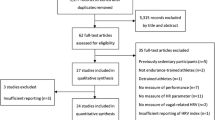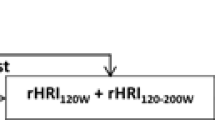Abstract
Purpose
This study aimed at examining the autonomic cardiovascular modulation in well-trained masters and young cyclists following high-intensity interval training (HIT).
Methods
Nine masters (age 55.6 ± 5.0 years) and eight young cyclists (age 25.9 ± 3.0 years) completed a HIT protocol of 6 x 30 sec at 175% of peak power output, with 4.5-min’ rest between efforts. Immediately following HIT, heart rate and R–R intervals were monitored for 30-min during passive supine recovery. Autonomic modulation was examined by i) heart rate recovery in the first 60-sec of recovery (HRR60); ii) the time constant of the 30-min heart rate recovery curve (HRRτ); iii) the time course of the root mean square for successive 30-sec R–R interval (RMSSD30); and iv) time and frequency domain analyses of subsequent 5-min R–R interval segments.
Results
No significant between-group differences were observed for HRR60 (P = 0.096) or HRRτ (P = 0.617). However, a significant interaction effect was found for RMSSD30 (P = 0.021), with the master cyclists showing higher RMSSD30 values following HIT. Similar results were observed in the time and frequency domain analyses with significant interaction effects found for the natural logarithm of the RMSSD (P = 0.008), normalised low-frequency power (P = 0.016) and natural logarithm of high-frequency power (P = 0.012).
Conclusion
Following high-intensity interval training, master cyclists demonstrated greater post-exercise parasympathetic reactivation compared to young cyclists, indicating that physical training at older ages has significant effects on autonomic function.


Similar content being viewed by others
References
Albinet C, Boucard G, Bouquet C, Audiffren M (2010) Increased heart rate variability and executive performance after aerobic training in the elderly. Eur J Appl Physiol 109:617–624
Billman GE (2002) Aerobic exercise conditioning: a nonpharmacological antiarrhythmic intervention. J Appl Physiol 92:446–454
Borges N, Reaburn P, Driller M, Argus C (2015) Age-related changes in performance and recovery kinetics in masters athletes: a narrative review. J Aging Phys Act 24(1):149–157
Borresen J, Lambert MI (2008) Autonomic control of heart rate during and after exercise. Sports Med 38:633–646
Buchheit M, Gindre C (2006) Cardiac parasympathetic regulation: respective associations with cardiorespiratory fitness and training load. Am J Physiol Heart Circ Physiol 291:H451–H458
Buchheit M, Laursen PB, Ahmaidi S (2007) Parasympathetic reactivation after repeated sprint exercise. Am J Physiol Heart Circ Physiol 293:H133–H141
Carter JB, Banister EW, Blaber AP (2003) Effect of endurance exercise on autonomic control of heart rate. Sports Med 33:33–46
Darr KC, Bassett DR, Morgan BJ, Thomas DP (1988) Effects of age and training status on heart rate recovery after peak exercise. Am J Physiol 254:H340–H343
Goldberger JJ, Le FK, Lahiri M, Kannankeril PJ, Ng J, Kadish AH (2006) Assessment of parasympathetic reactivation after exercise. Am J Physiol Heart Circ Physiol 290:H2446–H2452
Hawley J, Noakes T (1992) Peak power output predicts maximal oxygen uptake and performance time in trained cyclists. Eur J Appl Physiol Occup Physiol 65:79–83
Lee CM, Mendoza A (2012) Dissociation of heart rate variability and heart rate recovery in well-trained athletes. Eur J Appl Physiol 112:2757–2766
Leti T, Bricout VA (2013) Interest of analyses of heart rate variability in the prevention of fatigue states in senior runners. Auton Neurosci 173:14–21
Lipinski MJ, Vetrovec GW, Froelicher VF (2004) Importance of the first two minutes of heart rate recovery after exercise treadmill testing in predicting mortality and the presence of coronary artery disease in men. Am J Cardiol 93:445–449
Londeree BR, Moeschberger ML (1982) Effect of age and other factors on maximal heart rate. Res Q Exerc Sport 53:297–304
Messinger-Rapport B, Snader CEP, Blackstone EH, Yu D, Lauer MS (2003) Value of exercise capacity and heart rate recovery in older people. J Am Geriatr Soc 51:63–68
Motulsky H, Christopoulos A (2004) Fitting models to biological data using linear and nonlinear regression: a practical guide to curve fitting. GraphPad Software Inc, San Diego
Nakamura F, Soares-Caldeira L, Laursen P, Polito M, Leme L, Buchheit M (2009) Cardiac autonomic responses to repeated shuttle sprints. Int J Sports Med 30:808
Plews D, Laursen P, Kilding A, Buchheit M (2012) Heart rate variability in elite triathletes, is variation in variability the key to effective training? A case comparison. Eur J Appl Physiol 112:3729–3741
Rahman F, Pechnik S, Gross D, Sewell L, Goldstein DS (2011) Low frequency power of heart rate variability reflects baroreflex function, not cardiac sympathetic innervation. Clin Auton Res 21:133–141
Reaburn P, Dascombe B (2009) Anaerobic performance in masters athletes. Eur Rev Aging Phys A 6:39–53
Seals DR, Taylor JA, Ng AV, Esler MD (1994) Exercise and aging: autonomic control of the circulation. Med Sci Sports Exerc 26:568–576
Seiler S, Haugen O, Kuffel E (2007) Autonomic recovery after exercise in trained athletes: intensity and duration effects. Med Sci Sports Exerc 39:1366
Seiler S, Haugen O, Kuffel E (2007) Autonomic recovery after exercise in trained athletes: intensity and duration effects. Med Sci Sports Exerc 39:1366–1373
Shantsila A, McIntyre DB, Lip GY, Fadel PJ, Paton JF, Pickering AE, Fisher JP (2015) Influence of age on respiratory modulation of muscle sympathetic nerve activity, blood pressure and baroreflex function in humans. Exp Physiol 100:1039–1051
Sloth M, Sloth D, Overgaard K, Dalgas U (2013) Effects of sprint interval training on VO2max and aerobic exercise performance: a systematic review and meta-analysis. Scand J Med Sci Sports 23:e341–e352
Soares-Miranda L, Sattelmair J, Chaves P, Duncan G, Siscovick DS, Stein PK, Mozaffarian D (2014) Physical activity and heart rate variability in older adults: the cardiovascular health study. Circ 113:005361
Stuckey M, Tordi N, Mourot L, Gurr L, Rakobowchuk M, Millar P, Toth R, MacDonald M, Kamath M (2012) Autonomic recovery following sprint interval exercise. Scand J Med Sci Sports 22:756–763
Tarvainen MP, Niskanen J-P, Lipponen JA, Ranta-Aho PO, Karjalainen PA (2014) Kubios HRV—heart rate variability analysis software. Comput Methods Programs Biomed 113:210–220
Task Force of the European Society of Cardiology, the North American Society of Pacing and Electrophysiology (1996) Heart rate variability. Standard of measurement, physiological interpretation and clinical use. Circulation 93:1046–1065
Tzankoff SP, Norris AH (1979) Age-related differences in lactate distribution kinetics following maximal exercise. Eur J Appl Physiol Occup Physiol 42:35–40
Ueno LM, Moritani T (2003) Effects of long-term exercise training on cardiac autonomic nervous activities and baroreflex sensitivity. Eur J Appl Physiol 89:109–114
Williams DP, Jarczok MN, Ellis RJ, Hillecke TK, Thayer JF, Koenig J (2016) Two‐week test–retest reliability of the Polar® RS800CX™ to record heart rate variability. Clin Physiol Funct Imaging. Published ahead of print doi:10.1111/cpf.12321
Zhang J (2007) Effect of age and sex on heart rate variability in healthy subjects. J Manipulative Physiol Ther 30:374–379
Author information
Authors and Affiliations
Corresponding author
Ethics declarations
Conflicts of interest
The authors report no conflicts of interest.
Rights and permissions
About this article
Cite this article
Borges, N.R., Reaburn, P.R., Doering, T.M. et al. Autonomic cardiovascular modulation in masters and young cyclists following high-intensity interval training. Clin Auton Res 27, 83–90 (2017). https://doi.org/10.1007/s10286-017-0398-6
Received:
Accepted:
Published:
Issue Date:
DOI: https://doi.org/10.1007/s10286-017-0398-6




